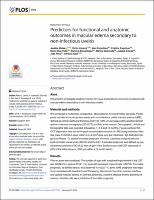Predictors for functional and anatomic outcomes in macular edema secondary to non-infectious uveitis
Resum
Paraules clau
Predictors; Edema macular; Uveïtis no infecciosa
Citació recomanada
Matas J, Llorenç V, Fonollosa A, Esquinas C, Diaz-Valle D, Berasategui B, et al. Predictors for functional and anatomic outcomes in macular edema secondary to non-infectious uveitis. PLoS One. 2019;14(1):e0210799.
Audiència
Professionals
Empreu aquest identificador per citar i/o enllaçar aquest document
https://hdl.handle.net/11351/3822Aquest element apareix a les col·leccions següents
- VHIR - Articles científics [1195]
Els següents fitxers sobre la llicència estan associats a aquest element:

